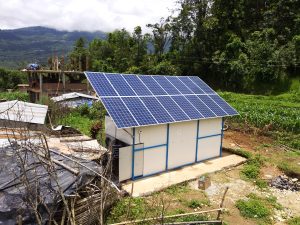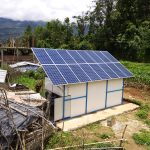A Mobile, Solar-Powered Solution for Post-Harvest Crop Preservation
Project Details:
1. The Problem: Small-scale farmers in rural Uganda face significant post-harvest losses due to inadequate drying and storage facilities. The lack of access to electricity, unpredictable weather, and traditional, inefficient drying methods (like sun-drying on the ground) lead to spoilage, fungal growth, and reduced crop quality. This directly impacts their income, food security, and ability to sell crops at a competitive price.
2. The Solution: “M-Aged” is an innovative, low-cost, and sustainable engineering project designed to address this challenge head-on. The system is a mobile unit built from locally available materials, featuring:
- Integrated Solar-Powered Dryer: The core of the system is a closed-loop drying chamber. It uses a small, but powerful, solar-powered fan to circulate warm, dry air through the crops, ensuring consistent and rapid drying regardless of the weather. The fan and control systems are powered by a compact solar panel and battery, making it entirely off-grid.
- Modular Storage Pods: After drying, the crops are transferred to a series of modular, hermetically sealed storage pods. These pods are designed to be airtight and rodent-proof, preventing moisture reabsorption and spoilage. Their modular nature allows farmers to store different types of crops simultaneously and scale up as needed.
- Mobile Platform: The entire unit is built on a durable, wheeled platform (like a modified handcart or a small trailer) that can be easily moved by a single person or attached to a bicycle or “boda-boda” motorcycle. This mobility allows the system to be shared among a small community or to be moved to different fields as needed.
- Built-in IoT Sensor: A simple, low-cost sensor integrated into the drying chamber monitors temperature and humidity. This data is transmitted to a basic mobile app, allowing the user to track the drying process and receive alerts when the crops are at the optimal dryness level. The app is designed to be accessible on low-end smartphones and uses minimal data.
3. Engineering & Design Considerations:
- Material Selection: The design prioritizes the use of locally sourced materials to reduce cost and promote local manufacturing. This includes wood for the frame, recycled metal sheets for the outer shell, and bamboo or other natural fibers for insulation.
- Thermal Efficiency: The drying chamber’s design focuses on maximizing thermal efficiency. This includes using a dark, heat-absorbing color for the outer surface and creating an internal structure that ensures uniform airflow.
- Ease of Use & Maintenance: The system is engineered to be simple to operate and maintain, even for a user with limited technical skills. All components can be easily replaced or repaired by a local technician, and the modular design simplifies cleaning and handling.
- Scalability & Community Impact: The “M-Aged” system is not just a product but a community solution. It can be implemented on a shared basis, with several farmers pooling resources to purchase one unit. This promotes collaboration and economic empowerment within rural communities, creating a new service-based micro-economy around crop preservation.
4. Why This Project is a Good Example:
This project embodies the “grassroots to innovation” theme because it:
- Addresses a core local problem with a direct and measurable impact.
- Relies on resourceful, low-cost engineering using local materials and ingenuity.
- Integrates modern technology (solar power, IoT) in a simple and appropriate way.
- Creates a model for sustainable development that is both economically viable and environmentally friendly.


